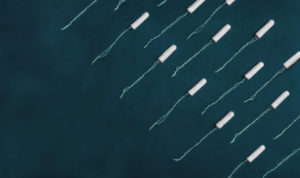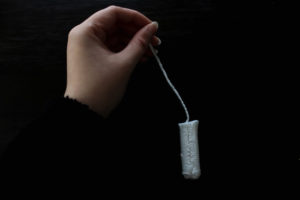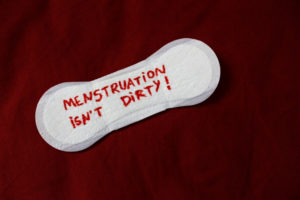 Ignorance is bliss in many aspects of our lives. None more so, than when we absent mindedly use convenient sanitary products.
Ignorance is bliss in many aspects of our lives. None more so, than when we absent mindedly use convenient sanitary products.
I mean it’s certainly easier than considering if these absorbent inserts or shields somehow add to our toxin load. The inconvenient (and unfortunate) truth is, however, that over long periods of use – they certainly can!
So just how worrisome are the ingredients of these products?
Is one form better than another?
Well, the ingredient list of most sanitary products is worrisome enough that legislation in America calling for manufacturers to disclose their ingredients has been put forward nine times and the Bill “for transparency” keeps being blocked.
Why the lack of transparency?
Good question, it sounds a lot like the tobacco industry playbook, or Teflon’s, or Monsanto’s. Where industries collude and lobby regulators or politicians to block or operate outside of, chemical safety laws.
To make matters worse these companies have also had the added safeguard against disclosing their ingredients, ever since the FDA deemed sanitary products – as “medical devices” …. and since medical devices don’t need to disclose their ingredients according to FDA policy, it may be quite some time until we know what truly lurks within these feminine products.
So Just What’s in Our Sanitary Products and What Are the Lifelong Effects of Such Negligible Exposures?
This quote from Dr. Philip Tierno of NYU School of Medicine sums up the issue:
“Every single product contained in a tampon has to be researched. We already know the fibers contain dozens of chemicals; polyester contains hundreds of chemicals. It’s not just a fiber you put in the vaginal vault.”
“Sure, one tampon is trace, but consider the menstrual lifetime of a woman. They use approximately 12,000 tampons in a lifetime. That means 12,000 exposures of dioxin … five, six, seven times a day. That’s a lot of dioxins absorbed directly through the vagina. It goes directly into the blood.”
Does the concern lay solely with tampons then?
No. While tampons are likely to be more toxic, sanitary pads have also been found to be incredibly noxious.
Recent tests by a research group found that the pads emit styrene, a component in car tyres which is a known carcinogen and hormone disrupter. The researchers also found traces of chloroethane, acetone, and chloroform. Chloroethane, also used in petroleum refining, is suspected of having neurological effects, including causing unconsciousness according to the Centres for Disease Control. Acetone is a key ingredient in nail polish remover. There were also pesticide residues, too, most likely from the non-organic cotton.
The company that manufactured the pads also manufactures tampons, said that the level of these contaminants is so low that there should be no concern, and, these contaminants exist in the ambient air, so there’s no problem. Other industry heavy hitters joined in dismissing the findings.
“There is more styrene in strawberries than there is in the air sample they measured in this study,”
said Tucker Helmes, who represents the Centre for Baby and Adult Hygiene Products. But the fact is that we’re not talking about a single exposure, and styrene is just one of a soup of unknown toxins that might well be present.
Ingredients to ponder:
In April 2018, Women’s Voices for the Earth sent six popular brands of U.S. tampons to a lab to see what ingredients they could discover. They tested for volatile organic compounds – a suite of over 100 toxic air pollutants that can be tested for simultaneously. We discovered that for some brands – there appears to be more complexity (and chemical emissions) than others. They tested Tampax Pearl (scented), UbyKotex Fitness, Playtex Sport (scented), Safe & Soft (Dollar Store), Seven Generation, Natracare.1
The testing was conducted by a certified laboratory STAT Analysis Corporation of Chicago, IL, using a standard EPA methodology for determining VOCS (volatile organic compounds) in the air (headspace) surrounding the product (EPA Method TO-15). The following information is a combination of the ingredients that they found and other accounts of ingredients.
*BPS and BPA.
Sanitary pads and tampons that we use each month, contrary to popular belief, are not just made with cotton, they are mostly made with plastic materials, and can include BPS and BPA. These chemicals themselves can already hinder the growth of an embryo and damage your own organs if you are exposed to them for too long. The highly absorbent products contain fiber that has been shown to cause cervical cancer and dioxin, which can lead to ovarian cancer.2
 For sanitary products to be absorbent, they do not just consist of cotton, they also plenty of synthetic fibers, such as furan and rayon.
For sanitary products to be absorbent, they do not just consist of cotton, they also plenty of synthetic fibers, such as furan and rayon.
*Rayon.
Rayon is made from purified cellulose, commonly came from wood pulp, and then converted into a soluble compound. The rayon which is contained in tampon normally high absorbent viscose rayon.
Rayon is known to contain dioxin, an incredibly harmful and noxious chemical that is released when it is bleached and is known to not break down in the environment. Carbon disulfide is the chemical we detected most frequently in our testing. Carbon disulfide is a chemical commonly used in the production of rayon. Results detected carbon disulfide emissions from all four tampons that contain rayon, but it was not detected in either of the all-cotton tampons. Exposure to carbon disulfide among female workers in rayon manufacturing plants has been associated with increased risk of menstrual disorders, early menopause, and hormonal disturbances.3 Other studies of rayon workers have linked both adverse cardiovascular and neurological impacts with carbon disulfide exposure.4
*Furan
Furan is a harmful substance that is found in cotton, and it stays there until the crop is processed. Furan itself, it has already been linked to certain cancers, and now we are giving it free access to one of the most absorbent and delicate places in our bodies, basically giving it a free pass to enter our reproductive systems.5
*Dioxin
Dioxin – Many manufacturers in the past have claimed that the levels of dioxin used to bleach the cotton is extremely low and shouldn’t cause any health concerns. We see a slight problem with this. If an average woman has 12 periods a year, for 5 days a time, from when they first get their periods at a blooming young age all the up to the point of menopause, she could use about twelve thousand products, but can be as many as sixty thousand. Micro scoping amounts in one tampon might be fine, but for trace amounts, for 5 days straight, every month, for 30+ years, can really add up.
According to recent studies, even short-term exposure to dioxin has been seen to cause skin darkening and alters the function of the liver. Over time, dioxin can also cause hormone dysfunction, ovarian cancer, diabetes, pelvic inflammatory disease, and damage to the immune system…Just to name a few.6
*Chlorine
Chlorine is commonly used to disinfect and whiten the raw materials used in sanitary products and using this releases dioxin. Dioxin is a known carcinogen, and not only harms your vaginal walls, but it can also migrate to the uterus and ovaries as well, which can affect potential fetuses in the future.
Chlorine is used basically because it is the cheapest option, never mind the danger. However, in organic tampons for example, they tend to use hydrogen peroxide instead, which doesn’t leave behind any carcinogenic chemicals.
*Pesticides and Herbicides
Pesticides and herbicides – Cotton will never just come by itself, as it is a crop, it also comes hand in hand with various pesticides and herbicides that have been previously linked to infertility, thyroid problems and much, much more. We have a blog series on one of the biggest hitters ‘glyphosate’ if you would like more information about it and its health effects.
*Fragrances
Fragrances – Similarly, scented products tend to be known to be particularly harmful due to their excess chemicals, so yes, although we don’t want it to smell funny, scented sanitary products are not the way to go!
*Additives
Additives – may be used in most tampons include: Myreth-3-myristate as lubricant, Natural and synthetic zeolites which plays role as odour-absorbing particles, Alcohol ethoxylates, Glycerol esters, polysorbate-20 as surfactants to disperse fragrance, unnamed anti-bacterial agents.
*Other Toxic Chemicals
Other toxic chemicals – detected in the testing included (methylene chloride, methyl ethyl ketone, ethyl acetate, m,p-xylene, heptane, hexane, toluene). These chemicals could be coming from fragrance, another undisclosed additive, or possibly as contaminants of the tampon manufacturing process. More research is needed to better understand the sources and potential impacts of exposures to these chemicals from tampon use.
All in all, we can now easily see that in favour of having wonderfully packaged and neat, clean products, women are exposing themselves to untold health dangers.
 Up to 85% of women in the US opt to use tampons and we understand! Tampons are convenient and discreet. However, tampons are directly up against our delicate vaginal walls excreting all the chemicals we have outlined, but not only that, as they absorb blood, they also absorb other lubricating factors, leaving the internal environment of our vaginas dry and a perfect breeding ground for bacteria. Leaving our vagina vulnerable to yeast infections and allergies.
Up to 85% of women in the US opt to use tampons and we understand! Tampons are convenient and discreet. However, tampons are directly up against our delicate vaginal walls excreting all the chemicals we have outlined, but not only that, as they absorb blood, they also absorb other lubricating factors, leaving the internal environment of our vaginas dry and a perfect breeding ground for bacteria. Leaving our vagina vulnerable to yeast infections and allergies.
According to many Eastern philosophies our monthly menstruations are our reproductive system’s way of detoxing and purging. By using a tampon, or any other product that must ‘go in’ and act as a ‘plug’, we are stopping that flow and creating stagnation in a process that is supposed to be free moving. Interesting.
As we have already outlined though – sanitary pads have their own set of drawbacks. When worn for prolonged time, usually about 3 hours, they may cause vaginal lumps, pimples and bumps that can lead to irritation and other infections. This could be attributed the chemicals found as ingredients and the copious amounts of pesticides found on the cotton, all of which act as endocrine disruptors off setting our incredibly complex reproductive organs.
Advances in research on health impacts of period products can help us better understand and prevent the potential impacts of these exposures. It is reasonable to want to know about the presence (or absence) of a reproductive toxin, carcinogen, irritant, or allergen in any of our sanitary products. Improved ingredient disclosure which could indicate the presence or absence of chemicals of concern would aid in making informed choices of period products. In an ideal world we would pass laws that require universal disclosure of ingredients in these products to ensure consistency in labelling. Given our ignorance about what tampons and other sanitary products contain, experts advise women to use the lowest absorbency product possible, to remove tampons as soon as possible, and to avoid scented products. It also makes sense to use organic products. We love the Toms Organic and other 100% organic brands of tampons and pads if you’re set on using this form of sanitary product.
What Else Do We Need to Consider:
Let’s also take a moment to consider the impact of these products on landfill not to mention the toxin load they add to our environment via landfill. More than 660 million disposable feminine products end up in landfill every year in Australia alone. That’s just one country. Here’s another way of considering the impact – one individual goes through approximately 11,000 disposable pads and/or tampons in a lifetime.
Fortunately, there are more and more options arising including reusable underwear and menstrual cups. The first question we asked is – “how safe are they?”
Let’s look.
Other Options:
Menstrual Cups
A menstrual cup is a reusable alternative to the common menstrual hygiene products, pads, and tampons. There are two types: vaginal and cervical. The vaginal cup is placed in the vagina, and the cervical cup is placed around the cervix, high in the vagina. If you’re using a reusable menstrual cup, you empty the cup when it’s full, wash it and then place it back in your vagina. Devices can last up to 10 years. If you’re using a disposable menstrual cup, you discard it after using it. A reusable menstrual cup is thicker and more durable and is not meant to be used during sex. A disposable menstrual disc however that provides 12 hours of period protection (it is not reusable though) is designed to sit in the vaginal fornix, (which is at the base of the cervix) and not in the vaginal canal, so it can be worn during period sex. These discs seem to be made from a polymer plastic which as you know any plastic is less than ideal for our toxin load.
One advantage is that a menstrual cup collects your blood rather than absorbs it. These cups have a stem that is used for insertion and removal, and there are different sizes to fit everyone’s size and flow. Sizes can be based on your flow or your age and whether you have delivered children vaginally.
The menstrual cup should be emptied every four to 12 hours, depending on your menstrual flow and the type of cup being used. Research suggests that leakage from a menstrual cup is like or less than that from using pads and tampons. These cups do require maintenance and proper cleaning.
Menstrual cups are typically made of silicone or rubber. Some are made of latex which poses an issue for women who have allergic reactions to latex. Much like with pads and tampons, there are many brands and features to consider.
The reusable Lunette Menstrual Cup has a lot of fans due to being easier to use (just fold and insert). It also comes in a variety of sizes, colours, and is available in two capacities (Model 1 for light flow and Model 2 for normal or heavy flow). The “v” shaped, silicone and BPA-free cup can be used for up to 12 hours. Conveniently, the Lunette comes with a pouch to hold your cup and fits into your bag. Another good option is Loop Cup – a natural rubber menstrual cup that is non-toxic, plant based and plastic free.
Menstrual cups can be more cost-effective than tampons and pads and are eco-friendly.

Period Underwear?
Period underwear is designed to look and feel like regular underwear, but with extra layers and highly absorbent fabrics in the crotch area to absorb menstrual blood. They are usually offered in various levels of absorbency, each designed to be worn at different times within a given menstrual cycle. A single pair of underwear can hold anywhere from one to four tampons’ worth of flow, so wearers are encouraged to experiment to discover the number of pairs they need within a cycle, depending on personal flow.
Cleaning period underwear is fairly simple; it is recommended that you rinse them in cold water immediately after use, then machine wash them on a delicate cycle, and then allow them to air dry (they do not hold up well over time if they are put in the dryer). With proper care, this reusable product can last on average 6 months to 2 years, as this is dependent on the wash, use and care of the garment.
Although period underwear is usually designed to be stain-resistant and should not smell bad if cleaned properly, if you are concerned about either of these possibilities, you are advised to soak them in a vinegar-and-water mixture before machine washing.
Our advice:
The most important thing is that we recommend researching each product before you buy them. Whether they’re pads, tampons, period underwear or menstrual cups, using organic products that aren’t just beneficial from the environment but also good for your body is essential. Find a method works for you, but make sure to use organic materials such as cotton, and don’t be afraid to question and take your time to be sure!
Your’s in Health,
Jennifer Barham-Floreani
(Bach. Chiropractic, Bach. App Clinical Science
Registered internationally, no longer practicing as a chiropractor in Australia.)
References:
1. https://www.womensvoices.org/menstrual-care-products/whats-in-your-tampon/
2. Matuszczak E, Komarowska MD, Debek W, Hermanowicz A. The Impact of Bisphenol A on Fertility, Reproductive System, and Development: A Review of the Literature.Int J Endocrinol. 2019;2019:4068717. Published 2019 Apr 10. doi:10.1155/2019/4068717
3. Sieja K, Mach-Szczypinski J and Mach-Szczypinski J (2018) Health effect of chronic exposure to carbon disulfide (CS2) on women employed in viscose industry. Medycyna Pracy. Vol. 69, No. 3. 2018.
4. Gelbke HP, Goen T, Maurer M and Sulsky S. (2009) A review of health effects of carbon disulfide in viscose industry and a proposal for an occupational exposure limit. Critical Reviews in Toxicology, Vol 39 (S2): 1-126. 2009.
5. Dong, Hongyan et al. “Toxicogenomic assessment of liver responses following subchronic exposure to furan in Fischer F344 rats.” Archives of toxicology vol. 90,6 (2016): 1351-67. doi:10.1007/s00204-015-1561-2
6. EFSA Panel on Contaminants in the Food Chain (CONTAM), Knutsen HK, Alexander J, Barregård L, Bignami M, Brüschweiler B, Ceccatelli S, Cottrill B, Dinovi M, Edler L, Grasl-Kraupp B, Hogstrand C, Nebbia CS, Oswald IP, Petersen A, Rose M, Roudot AC, Schwerdtle T, Vleminckx C, Vollmer G, Wallace H, Fürst P, Håkansson H, Halldorsson T, Lundebye AK, Pohjanvirta R, Rylander L, Smith A, van Loveren H, Waalkens-Berendsen I, Zeilmaker M, Binaglia M, Gómez Ruiz JÁ, Horváth Z, Christoph E, Ciccolallo L, Ramos Bordajandi L, Steinkellner H, Hoogenboom LR. Risk for animal and human health related to the presence of dioxins and dioxin-like PCBs in feed and food. EFSA J. 2018 Nov 20;16(11):e05333. doi: 10.2903/j.efsa.2018.5333. PMID: 32625737; PMCID: PMC7009407.



